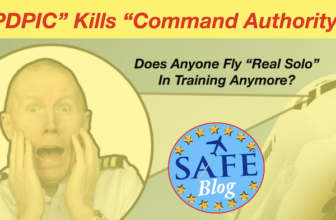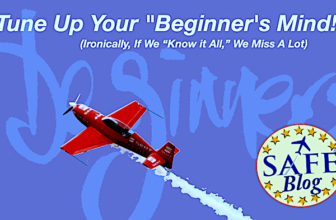
Necessary changes to 30 FAA test standards will be published tomorrow in the Federal Register. Some of these changes have been held up for 6 years. To quote the FAA: no big deal! The CFI Airplane ACS however is a whole new document! We will be analyzing this for weeks to come…
The FAA notes that, while certain revisions were made to the ACS and PTS as an outgrowth of public notice and comment, there are no major substantive changes to the testing standards already in use or the conduct of the practical test such that the scope of the practical test is altered. Rather, this final rule brings the ACS and PTS into the FAA regulations through the proper notice and comment process required by the Administrative Procedure Act (APA).
The CFI ACS however is a whole new document! (Updated from 2012 version)
We will keep you updated as we dig through this for significant issues. I am comparing a paper copy with a pdf so apologies until there is time that allows for a deeper dive. DPEs will also wait for guidance from the mother ship on these changes and testing expectations. 1) Minimum Controllable Airspeed (MCA) is finally back so flight with the stall warner just above a stall is back. SAFE argued aggressively to never remove this (a total surprise when the private ACS was published). Understanding (and controlling) flight in “the region of reversed command” is critical to safety and CFIs testing will be required to explain and demonstrate this maneuver: A/O X
1) Minimum Controllable Airspeed (MCA) is finally back so flight with the stall warner just above a stall is back. SAFE argued aggressively to never remove this (a total surprise when the private ACS was published). Understanding (and controlling) flight in “the region of reversed command” is critical to safety and CFIs testing will be required to explain and demonstrate this maneuver: A/O X 
 I notice there is a requirement now for the demonstration (and recovery) of a secondary stall (tested at the evaluator’s discretion). This addition provides more tools for the DPE. There has been an increasing unfounded fear among new CFIs regarding stalls and esp. accelerated or turning stalls (these can be tested on the private evaluation but only half the applicants are prepared for this). See this blog for more on “sneaky stalls” and the aerodynamics involved.
I notice there is a requirement now for the demonstration (and recovery) of a secondary stall (tested at the evaluator’s discretion). This addition provides more tools for the DPE. There has been an increasing unfounded fear among new CFIs regarding stalls and esp. accelerated or turning stalls (these can be tested on the private evaluation but only half the applicants are prepared for this). See this blog for more on “sneaky stalls” and the aerodynamics involved.
 The secondary stall, A/O X, Task H, requires the performance and recovery of a secondary stall and the associated knowledge and risk management elements. Task I, spins is required, so adequate knowledge will be assumed.
The secondary stall, A/O X, Task H, requires the performance and recovery of a secondary stall and the associated knowledge and risk management elements. Task I, spins is required, so adequate knowledge will be assumed.
Reviewing the FOI verbiage, it seems the FAA is more serious about ensuring solid pedagogical understanding rather just a rote recitation of the laws of learning (exactly what we preach in SAFE CFI-PRO™ and these SAFEblogs). Teaching risk management is also a specifically addressed focus:
Task F. Elements of Effective Teaching that Include Risk Management and Accident Prevention is entirely new: 3 specific objectives in the risk management objectives, and as it says in Appendix 2:
If an applicant fails to use aeronautical decision-making (ADM), including SRM/CRM, as applicable in any Task, the evaluator will note that Task as failed. The evaluator will also include the ADM Skill element from the Flight Deck Management Task on the Notice of Disapproval of Application.
Electronic Flight Planning is specifically permitted in the newest ACSs and has been FAA policy for years now. This note will probably be added to all the other ACSs (if it isn’t already).
To be clear, everyone’s knowledge test is still valid for two years, but if you are testing after the May 31st effective test, the new ACSs will be used. Fly safely out there (and often)!
 Visit SAFE in the Bravo hangar #82/3 at Sun N’ Fun (April 9-14) and join our spring raffle for a Lightspeed Delta Zulu and other great prizes in our spring raffle! We are holding a “CFI-Roundup” on Saturday at 16:00 in the Prop 75 building (right by the exhibit hangars) and ice cream is offered to incentivize participation.
Visit SAFE in the Bravo hangar #82/3 at Sun N’ Fun (April 9-14) and join our spring raffle for a Lightspeed Delta Zulu and other great prizes in our spring raffle! We are holding a “CFI-Roundup” on Saturday at 16:00 in the Prop 75 building (right by the exhibit hangars) and ice cream is offered to incentivize participation.
 Our SAFE CFI-PRO™ webinar series continues with the presentation of “Incremental Mastery” on April 7th at 8pm EDT. Register here!
Our SAFE CFI-PRO™ webinar series continues with the presentation of “Incremental Mastery” on April 7th at 8pm EDT. Register here!
SAFE CFI-PRO™ provides “Missing Manual” of master CFI techniques (what the FAA did not teach you) for flight instructors to accelerate teaching performance from “good to great.” FAA Master WINGS credit is available for participation and the two YouTubes from previous webinars are available on the SAFE YouTube channel.





